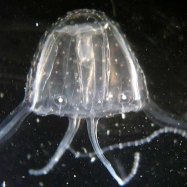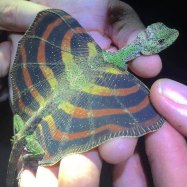
Silver Dollar
Up to 6 inches
The Silver Dollar, found in the Amazon River Basin, can grow up to 6 inches long. This popular aquarium fish belongs to the Characidae family and has a distinct laterally compressed and oval-shaped body. It's a peaceful species that can thrive in a well-maintained tank. #AmazonFish #SilverDollar #AquariumPets #Characidae
Animal Details Summary:
Common Name: Silver Dollar
Kingdom: Animalia
Habitat: Freshwater rivers and lakes
The Fascinating Silver Dollar Fish: A Jewel of the Amazon River Basin
The world is full of diverse and mesmerizing animal species, each with its unique characteristics and traits. One such remarkable creature that often captures our attention is the Silver Dollar fish. This small, silvery creature with a dark spot on its side may seem unassuming at first glance, but it holds within it a wealth of interesting facts and features. Let's dive deeper into the world of the Silver Dollar fish and discover what makes it such a unique and fascinating species Silver Dollar.The Silver Dollar fish, scientifically known as Metynnis argenteus, is a freshwater fish that belongs to the Characidae family. It is commonly found in the Amazon River Basin in South America and is native to Brazil. Its name is derived from its resemblance to a silver dollar coin, owing to its round and flat body shape.
As with most animals, the Silver Dollar fish has a scientific classification that helps us understand its place in the animal kingdom. It belongs to the kingdom Animalia, phylum Chordata, and class Actinopterygii. Within the class, it belongs to the order Characiformes, which includes many other popular aquarium fish species such as tetras and piranhas. This diverse order has over 2,000 species, but the Silver Dollar fish stands out with its unique features and behavior.
One of the first things that catch our eye about the Silver Dollar fish is its stunning coloration. It has a silver body with a dark spot near its tail, earning it the common name 'Silver Dollar Spiny Bush Viper.' However, what's fascinating is that this dark spot is not present on juvenile Silver Dollars and only develops as they mature. This spot is believed to serve as a defense mechanism, making it difficult for predators to tell which end is the head and which is the tail. Moreover, this dark spot also helps the fish blend into its surroundings, making it less visible to predators.
Apart from its coloration, the Silver Dollar fish's body shape is another unique feature worth noting. It has a laterally compressed and oval-shaped body, similar to a discus or even a coin. This shape allows them to easily navigate through the dense vegetation in their natural habitat, which primarily consists of freshwater rivers and lakes. They are also often found in flooded forests and floodplains.
At maturity, the Silver Dollar fish can reach a length of up to 6 inches. However, in captivity, they are usually smaller, reaching a maximum size of 4-5 inches. They have a lifespan of up to 10 years, making them a long-term commitment for aquarium owners. It is worth noting that the Silver Dollar fish prefers to be in groups, so it is recommended to keep at least 6-8 fish together to ensure their well-being.
Their omnivorous feeding method makes them relatively easy to care for in captivity. In the wild, they feed on a variety of food sources such as insects, plants, and small crustaceans. In captivity, they can be fed a well-balanced diet of flakes, pellets, and live or frozen foods. As with most fish species, it is essential to ensure the water quality is suitable, and the tank is adequately maintained to keep the Silver Dollar fish healthy.
The Silver Dollar fish's geographical distribution is limited to South America, specifically the Amazon River Basin. However, due to their popularity among aquarium owners, they have been introduced to other parts of the world, including the United States and Asia. Despite being introduced to new areas, the Silver Dollar fish is not considered an invasive species and does not pose any harm to the existing ecosystem.
In the wild, the Silver Dollar fish is known to engage in a unique behavior known as 'lip-locking.' During this behavior, several individuals will lock their lips together and swim in a circle, resembling a wheel. This behavior is believed to be a way of establishing dominance and hierarchy within the group. In captivity, they are relatively peaceful and can be kept with other peaceful fish species, making them a popular choice for community tanks.
In terms of reproduction, not much is known about the Silver Dollar fish. In the wild, they typically reproduce during the rainy season when there is an increase in water levels and food availability. Female Silver Dollar fish are believed to lay anywhere from 100-400 eggs, which are usually scattered amongst plants. Once the eggs hatch, the fry will feed on algae and other small organisms before moving onto larger food sources.
In addition to their captivating appearance and behavior, the Silver Dollar fish is also essential to the ecosystem of the Amazon River Basin. As omnivorous fish, they play a crucial role in maintaining the balance of the aquatic food chain. They act as a significant link between primary plant producers and larger predatory fish species.
In conclusion, the Silver Dollar fish is a jewel of the Amazon River Basin, with its unique features and behavior capturing the hearts of aquarium owners around the world. With their silvery color, round body, and lip-locking antics, they add both beauty and entertainment to any tank. Their role in the ecosystem further showcases their importance in the animal kingdom. So next time you come across a Silver Dollar fish, take a moment to appreciate the fascinating creature that it is.

Silver Dollar
Animal Details Silver Dollar - Scientific Name: Metynnis argenteus
- Category: Animals S
- Scientific Name: Metynnis argenteus
- Common Name: Silver Dollar
- Kingdom: Animalia
- Phylum: Chordata
- Class: Actinopterygii
- Order: Characiformes
- Family: Characidae
- Habitat: Freshwater rivers and lakes
- Feeding Method: Omnivorous
- Geographical Distribution: South America
- Country of Origin: Brazil
- Location: Amazon River Basin
- Animal Coloration: Silver with a dark spot on the side
- Body Shape: Laterally compressed and oval-shaped
- Length: Up to 6 inches

Silver Dollar
- Adult Size: 5-6 inches
- Average Lifespan: 5-8 years
- Reproduction: Egg-laying
- Reproductive Behavior: No parental care
- Sound or Call: Does not produce sound
- Migration Pattern: No specific migration pattern
- Social Groups: Schooling Fish
- Behavior: Peaceful and active
- Threats: Habitat loss, pollution, overfishing
- Conservation Status: Not evaluated (NE)
- Impact on Ecosystem: Important for nutrient cycling
- Human Use: Popular in tropical aquariums
- Distinctive Features: Silver body with a round shape
- Interesting Facts: The dark spot on their side acts as a camouflage in the wild
- Predator: Predators include larger fish, birds, and mammals

Metynnis argenteus
The Mysterious World of the Silver Dollar Fish
The world's oceans, rivers, and lakes are home to an incredible array of fascinating creatures. From tiny, colorful tropical fish to massive marine mammals, there is always something intriguing to discover. One such fish that has captured the attention of both hobbyists and researchers alike is the Silver Dollar fish or Metynnis argentus.The Silver Dollar fish is a freshwater species native to the Amazon basin in South America, specifically in countries such as Brazil, Colombia, and Peru PeaceOfAnimals.Com. It is often found in slow-moving water bodies such as rivers, streams, and flooded areas. This unique fish is beloved among aquarium enthusiasts for its distinctive appearance and peaceful behavior. In this article, we will dive into the mysterious world of the Silver Dollar fish and uncover its interesting features, behavior, and impact on its ecosystem.
### The Silver Dollar Fish: A Delightful Addition to Any Aquarium
The Silver Dollar fish, also known as the Silver Tropic Sunfish, is a small but eye-catching species that can grow up to 5-6 inches in adult size. This makes it an ideal fish for aquariums, as it does not require a large tank. With its silver body and round shape, the Silver Dollar fish is often compared to a coin, hence its name. Its scales have a reflective quality, giving the fish a shimmering appearance when it moves, making it a beautiful sight to behold.
But what makes this fish truly unique is its dark spot on its side, which acts as camouflage in the wild. This distinct feature helps the Silver Dollar fish blend in with its surroundings, providing protection from predators Savanna Goat. In captivity, this dark spot remains but is not as prominent as in the wild, adding to the fish's mysterious aura.
### Understanding the Behavior of the Silver Dollar Fish
The Silver Dollar fish is a fascinating creature with a peaceful and active demeanor. Being a schooling fish, it is usually found in groups in the wild and should also be kept in groups of at least four or five in an aquarium. Keeping them in groups mimics their natural habitat and keeps them happy and stress-free.
Interestingly, the Silver Dollar fish does not produce any sound or call, making it a silent creature. Its behavior is also quite interesting, as it is an egg-laying species with no parental care. This means that the female fish will lay eggs on plants or any other surface, and the male fish fertilizes them. After spawning, the parents will not protect or care for the eggs, and the young fry will be left to fend for themselves. This is a natural behavior among many fish species, and the Silver Dollar fish is no exception.
One of the most notable behaviors of the Silver Dollar fish is its schooling behavior. In their natural habitat, they form large schools to protect themselves from predators and to search for food. In captivity, this schooling behavior can be observed even with other species of fish, providing for a dynamic and visually stunning aquarium.
### Impressive Adaptations and Threats Faced by the Silver Dollar Fish
Besides its distinctive features and behavior, the Silver Dollar fish also has several impressive adaptations that allow it to thrive in its ecosystem. As a herbivore, it mainly feeds on small live and frozen foods, but its diet also includes algae and vegetation. This diet makes the Silver Dollar fish an essential part of nutrient cycling in its habitat. By consuming algae, it helps keep the water clean and free from excessive algae growth.
However, the Silver Dollar fish is also under threat due to various human activities. The most significant threats include habitat loss, pollution, and overfishing. The destruction of the fish's natural habitat through deforestation, damming of rivers, and pollution from industrial and agricultural activities can have a devastating effect on its population. Overfishing is also a major concern, as the Silver Dollar fish is commonly caught for both the aquarium trade and for food.
### Promoting Conservation: Evaluating the Silver Dollar Fish
Sadly, the Silver Dollar fish has not been evaluated by the International Union for Conservation of Nature (IUCN) and currently holds a "Not Evaluated" (NE) conservation status. This means that researchers and conservationists have not yet studied the population and threats to this species to determine its level of endangerment.
The absence of conservation measures for the Silver Dollar fish is a significant concern, considering the threats it faces. More research and data collection on its population and habitat are vital in determining its conservation status and implementing effective conservation measures.
### Silver Dollar Fish: More than Just an Aquarium Species
While the Silver Dollar fish is a popular aquarium fish, it plays an important role in its ecosystem. As mentioned earlier, its diet helps in nutrient cycling, which is vital for maintaining a healthy aquatic environment. In the Amazon basin, the Silver Dollar fish is also an important prey species for larger fish, birds, and mammals. Its loss could have a ripple effect on the entire ecosystem.
Furthermore, the Silver Dollar fish is increasingly being studied by researchers for its ability to regenerate nerve cells in the spinal cord. This makes it a promising candidate for potential treatments for spinal cord injuries in humans. This shows that the Silver Dollar fish is more than just a beautiful addition to an aquarium, but also holds potential for medical advancements.
### Human Use and Conservation Efforts for the Silver Dollar Fish
The Silver Dollar fish's popularity in the tropical aquarium trade has led to its export from its natural habitat to other countries. This has raised concerns about the sustainability of the fish's population in the wild. While the export of this species is not banned, the Aquatic Life Export Program in Brazil has strict regulations in place to ensure it is done sustainably, with minimal impact on the fish's population and its ecosystem.
Another conservation effort for the Silver Dollar fish is through captive breeding programs. This involves breeding the fish in captivity and then releasing them into their natural habitat to supplement the wild population. While this method is not as effective as preserving the natural habitat, it is a step towards ensuring the species' survival.
### The Enigma of the Silver Dollar Fish: A Conclusion
The Silver Dollar fish is a truly remarkable species with a unique appearance and behavior. Its silver body, round shape, and camouflaging dark spot make it a beautiful addition to any aquarium. But beyond its aesthetic value, this fish also plays a crucial role in its ecosystem, making it an important species for conservation efforts.
To fully appreciate and understand the enigma of the Silver Dollar fish, more research and data collection are necessary. Its conservation status must also be evaluated to ensure its survival for years to come. As humans, it is our responsibility to protect and preserve the diverse flora and fauna of our planet, and the Silver Dollar fish is no exception. So, the next time you admire this fascinating fish in an aquarium, remember its significance and the role we play in its conservation.

The Fascinating Silver Dollar Fish: A Jewel of the Amazon River Basin
Disclaimer: The content provided is for informational purposes only. We cannot guarantee the accuracy of the information on this page 100%. All information provided here may change without prior notice.












